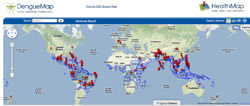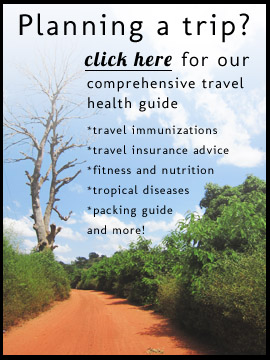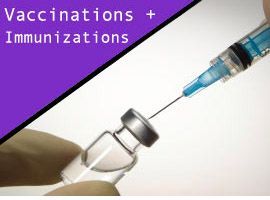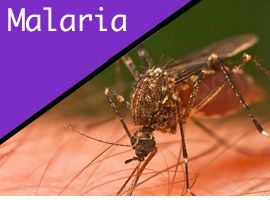Dengue fever is a mosquito borne infectious disease found in many tropical areas. Worldwide, dengue is not as destructive as malaria, but it does have the potential to be fatal and there is currently no vaccine. In this post, we discuss signs and symptoms, prevention and treatment.
Where can you get dengue fever?
 Dengue fever is found in many parts of the tropical world. For a detailed look at where dengue is endemic and where outbreaks are occurring, check out this excellent map from healthmap.org and the US Centers for Disease Control: Dengue Map
Dengue fever is found in many parts of the tropical world. For a detailed look at where dengue is endemic and where outbreaks are occurring, check out this excellent map from healthmap.org and the US Centers for Disease Control: Dengue Map
How do you get dengue fever?
Mosquitos. Specifically, Aedes mosquitoes. These mosquitoes bite primarily during the daytime. Some of the more common names are the yellow-fever mosquito (Aedes aegypti) and the Asian tiger mosquito (Aedes albopictus). Notice these are not the same mosquitoes that transmit malaria – those would be Anopheles mosquitoes. One bite from an infected Aedes mosquito could potentially be enough for you to get dengue fever.
Signs and Symptoms
- Dengue typically commences with an exceptionally high fever, often reaching and even exceeding 40 °C (104 °F).
- The fever is usually accompanied by headache, muscle and joint pain.
- A uniform red rash often appears shortly after the fever begins giving the infected person a flushed look.
- In many cases, this red rash will become textured and measles-like, with small red bumps all over the body.
- Nausea, fatigue and vomiting are also common symptoms.
It’s also worth noting that many cases of dengue are asymptomatic. In some cases, an infected person will only experience a mild fever. With that in mind, it’s important that you don’t shrug off dengue thinking it will just be a slight flu. There is no way way of knowing how your body will respond and dengue can potentially be a very serious illness.
How do you avoid it?
There is no vaccine for dengue fever, so your best and only line of defense is to do whatever you can to avoid bites.
- Apply mosquito repellant (try 3M Ultrathon Insect Repellent Lotion or, if you find DEET too harsh, try a picaridin product like Sawyer SP544 Insect Repellent, 20 Percent Picaridin)
- Sleep under a mosquito net (imperative)
- If possible, wear long sleeved clothing
- Use permethrin on your clothing (it will actually kill mosquitos when they come in contact with it) and on your mosquito net. See: Sawyer SP657 Permethrin Premium Insect Clothing Repellent
We have additional recommendations for insect repellants here.
Treatment
If you do come down with dengue fever, there is not much in the way of treatment. A common prescription for non-severe cases is to hydrate and treat the fever with acetaminophen. In more severe cases, intravenous fluids are provided. In most cases, dengue fever resolves in a week’s time. Regardless of the severity of your symptoms, you should go to a clinic for an official diagnosis and treatment plan.Can dengue fever be fatal?
In extremely rare cases (less than 5% of all cases), shock and hemorrhage can occur. Dengue hemorrhagic fever (a separate illness that can evolve out of the dengue fever virus) results in organ dysfunction and heavy bleeding, usually from within the GI tract. Treatment involves aggressive rehydration via intravenous fluids and in some cases, blood transfusion and oxygen therapy. The prognosis is generally positive if treatment is sought early and it is aggressive enough for the patient to avoid shock.
Other things to keep in mind
Dengue fever can be dormant for up to 14 days. In other words, 10 days after you return home, you could come down with dengue symptoms. You might think it is just the flu, but make sure to go to a doctor and make it clear that you were recently traveling in a dengue-endemic area.
You are more likely to contract dengue hemorrhagic fever if you’ve had dengue fever previously. It is still unclear what exactly causes the onset of dengue hemorrhagic fever, but the likelihood of contracting DHF increases significantly if you’ve been previously infected with a strain of the dengue virus.
The number of dengue fever cases around the world is on the rise. As it stands now, roughly 2/5 of the world’s population is at risk. From the WHO, The disease is now endemic in more than 100 countries in Africa, the Americas, the Eastern Mediterranean, South-east Asia and the Western Pacific. South-east Asia and the Western Pacific are the most seriously affected. Before 1970 only nine countries had experienced DHF epidemics, a number that had increased more than four-fold by 1995. (WHO Dengue Fact Sheet)
For more information on dengue fever as a traveler, see this CDC page.
Have you had dengue fever before? Please let us know about your experience in the comments.
Photo credit: http://www.flickr.com/photos/nightamazon/












{ 2 comments… add one }